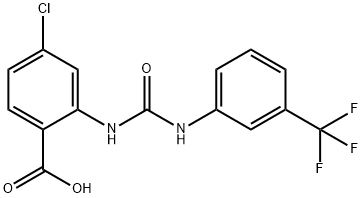Physicochemical Properties
| Molecular Formula | C15H10CLF3N2O3 |
| Molecular Weight | 358.6997 |
| Exact Mass | 358.033 |
| CAS # | 426834-38-0 |
| Related CAS # | 426834-38-0 |
| PubChem CID | 10109069 |
| Appearance | Solid |
| Density | 1.574g/cm3 |
| Boiling Point | 378.448ºC at 760 mmHg |
| Flash Point | 182.679ºC |
| Index of Refraction | 1.638 |
| LogP | 4.847 |
| Hydrogen Bond Donor Count | 3 |
| Hydrogen Bond Acceptor Count | 6 |
| Rotatable Bond Count | 3 |
| Heavy Atom Count | 24 |
| Complexity | 475 |
| Defined Atom Stereocenter Count | 0 |
| SMILES | ClC1C=CC(C(O)=O)=C(NC(NC2C=CC=C(C(F)(F)F)C=2)=O)C=1 |
| InChi Key | GNCZTZCPXFDPLI-UHFFFAOYSA-N |
| InChi Code | InChI=1S/C15H10ClF3N2O3/c16-9-4-5-11(13(22)23)12(7-9)21-14(24)20-10-3-1-2-8(6-10)15(17,18)19/h1-7H,(H,22,23)(H2,20,21,24) |
| Chemical Name | 4-chloro-2-[[3-(trifluoromethyl)phenyl]carbamoylamino]benzoic acid |
| Synonyms | NS 3694; NS3694; NS-3694 |
| HS Tariff Code | 2934.99.9001 |
| Storage |
Powder-20°C 3 years 4°C 2 years In solvent -80°C 6 months -20°C 1 month |
| Shipping Condition | Room temperature (This product is stable at ambient temperature for a few days during ordinary shipping and time spent in Customs) |
Biological Activity
| ln Vitro |
There is a dose-dependent inhibition of DEVDase activity, DFF45/ICAD and PARP cleavage, and caspase 9, 3, and 7 processing when cell extracts are stimulated with cytochrome c and dATP in the presence of NS3694 (10-100 μM; 120 min)[1]. NS3694 (10-100 μM) inhibits TNF-induced effector caspase activation and apoptosis in MCF-casp3 cells[1]. Inhibiting mitochondria-mediated apoptosis, NS3694 specifically inhibits the formation of the apoptosome complex and the activation of caspase-9 caused by cytochrome C. By preventing the initiator caspase-9's activation, NS3694 prevents the formation of the apoptosome Apaf-1[1]. |
| References |
[1]. Diarylurea compounds inhibit caspase activation by preventing the formation of the active 700-kilodalton apoptosome complex. Mol Cell Biol. 2003 Nov;23(21):7829-37. |
| Additional Infomation | 4-chloro-2-[[oxo-[3-(trifluoromethyl)anilino]methyl]amino]benzoic acid is a member of ureas. |
Solubility Data
| Solubility (In Vitro) | DMSO: ~250 mg/mL (~697.0 mM) |
| Solubility (In Vivo) |
Note: Listed below are some common formulations that may be used to formulate products with low water solubility (e.g. < 1 mg/mL), you may test these formulations using a minute amount of products to avoid loss of samples. Injection Formulations (e.g. IP/IV/IM/SC) Injection Formulation 1: DMSO : Tween 80: Saline = 10 : 5 : 85 (i.e. 100 μL DMSO stock solution → 50 μL Tween 80 → 850 μL Saline) *Preparation of saline: Dissolve 0.9 g of sodium chloride in 100 mL ddH ₂ O to obtain a clear solution. Injection Formulation 2: DMSO : PEG300 :Tween 80 : Saline = 10 : 40 : 5 : 45 (i.e. 100 μL DMSO → 400 μLPEG300 → 50 μL Tween 80 → 450 μL Saline) Injection Formulation 3: DMSO : Corn oil = 10 : 90 (i.e. 100 μL DMSO → 900 μL Corn oil) Example: Take the Injection Formulation 3 (DMSO : Corn oil = 10 : 90) as an example, if 1 mL of 2.5 mg/mL working solution is to be prepared, you can take 100 μL 25 mg/mL DMSO stock solution and add to 900 μL corn oil, mix well to obtain a clear or suspension solution (2.5 mg/mL, ready for use in animals). Injection Formulation 4: DMSO : 20% SBE-β-CD in saline = 10 : 90 [i.e. 100 μL DMSO → 900 μL (20% SBE-β-CD in saline)] *Preparation of 20% SBE-β-CD in Saline (4°C,1 week): Dissolve 2 g SBE-β-CD in 10 mL saline to obtain a clear solution. Injection Formulation 5: 2-Hydroxypropyl-β-cyclodextrin : Saline = 50 : 50 (i.e. 500 μL 2-Hydroxypropyl-β-cyclodextrin → 500 μL Saline) Injection Formulation 6: DMSO : PEG300 : castor oil : Saline = 5 : 10 : 20 : 65 (i.e. 50 μL DMSO → 100 μLPEG300 → 200 μL castor oil → 650 μL Saline) Injection Formulation 7: Ethanol : Cremophor : Saline = 10: 10 : 80 (i.e. 100 μL Ethanol → 100 μL Cremophor → 800 μL Saline) Injection Formulation 8: Dissolve in Cremophor/Ethanol (50 : 50), then diluted by Saline Injection Formulation 9: EtOH : Corn oil = 10 : 90 (i.e. 100 μL EtOH → 900 μL Corn oil) Injection Formulation 10: EtOH : PEG300:Tween 80 : Saline = 10 : 40 : 5 : 45 (i.e. 100 μL EtOH → 400 μLPEG300 → 50 μL Tween 80 → 450 μL Saline) Oral Formulations Oral Formulation 1: Suspend in 0.5% CMC Na (carboxymethylcellulose sodium) Oral Formulation 2: Suspend in 0.5% Carboxymethyl cellulose Example: Take the Oral Formulation 1 (Suspend in 0.5% CMC Na) as an example, if 100 mL of 2.5 mg/mL working solution is to be prepared, you can first prepare 0.5% CMC Na solution by measuring 0.5 g CMC Na and dissolve it in 100 mL ddH2O to obtain a clear solution; then add 250 mg of the product to 100 mL 0.5% CMC Na solution, to make the suspension solution (2.5 mg/mL, ready for use in animals). Oral Formulation 3: Dissolved in PEG400 Oral Formulation 4: Suspend in 0.2% Carboxymethyl cellulose Oral Formulation 5: Dissolve in 0.25% Tween 80 and 0.5% Carboxymethyl cellulose Oral Formulation 6: Mixing with food powders Note: Please be aware that the above formulations are for reference only. InvivoChem strongly recommends customers to read literature methods/protocols carefully before determining which formulation you should use for in vivo studies, as different compounds have different solubility properties and have to be formulated differently. (Please use freshly prepared in vivo formulations for optimal results.) |
| Preparing Stock Solutions | 1 mg | 5 mg | 10 mg | |
| 1 mM | 2.7878 mL | 13.9392 mL | 27.8784 mL | |
| 5 mM | 0.5576 mL | 2.7878 mL | 5.5757 mL | |
| 10 mM | 0.2788 mL | 1.3939 mL | 2.7878 mL |
